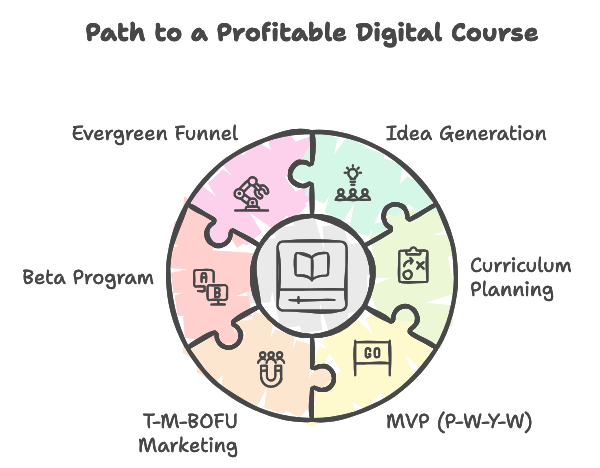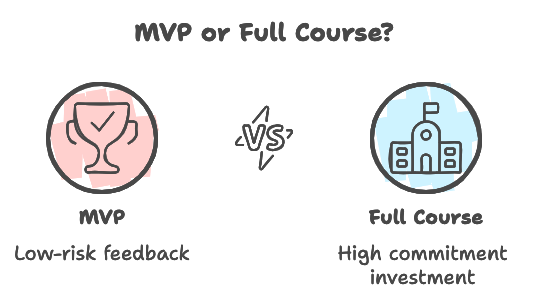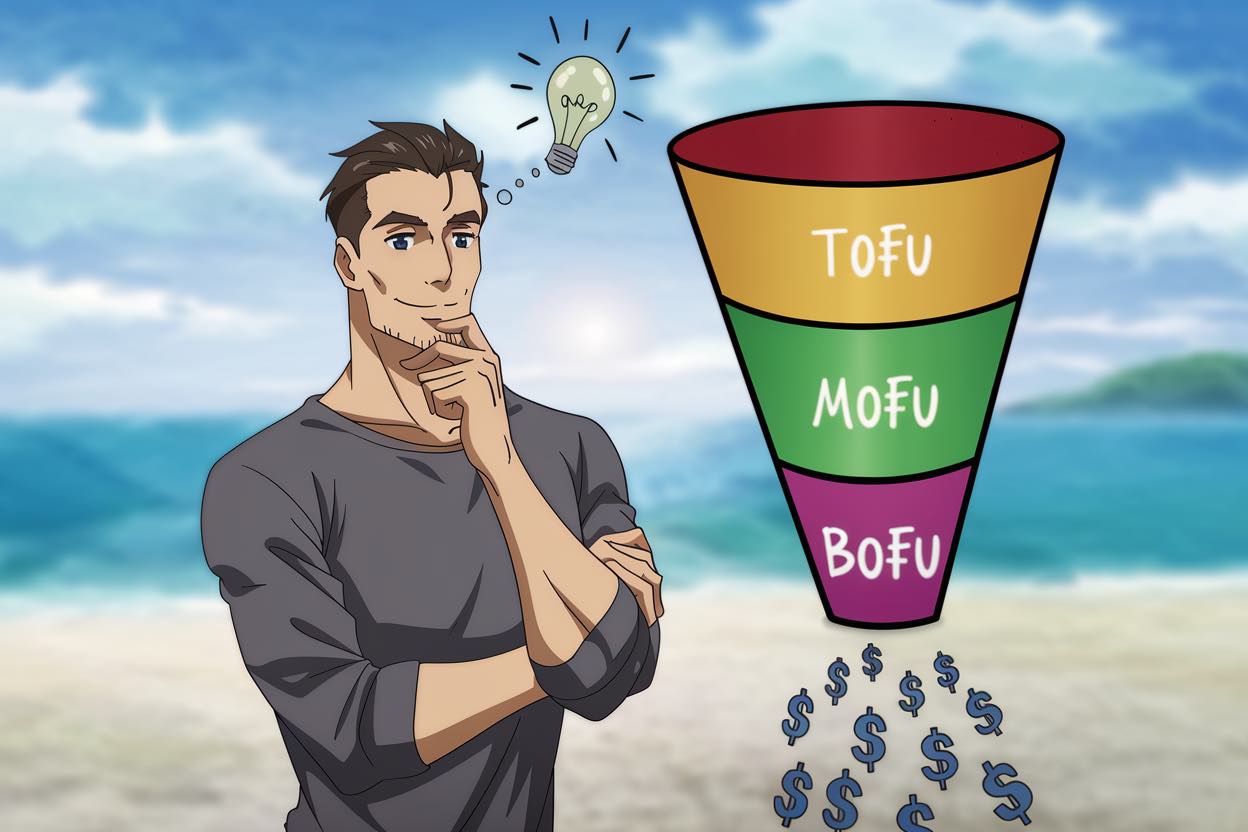6 Simple Steps to Go From Blank Page to Profitable Online Course Asset (And Lifestyle Freedom!)
Have you ever dreamed of creating a digital course that makes you money while you’re off doing… whatever you want?
Think about it: a course that sells itself while you sleep, travel, spend time with family—or binge that series you’ve been eyeing. No more trading hours for dollars, no more exhausting client work. Just a steady stream of income that frees you up to live life on your terms. Sounds pretty amazing, right?
But here’s the catch: creating a profitable digital course, especially if you’re staring at a blank page, can feel like standing at the bottom of a mountain with no map to the top. Daunting doesn’t even begin to cover it. If you’re a coach, consultant, or entrepreneur who knows they have something valuable to teach but just doesn’t know where to start, you’re not alone.
The good news? There is a roadmap. A clear, no-fluff, six-step process that takes you from “I think I have an idea” to “Hey, I just made my first sale in my sleep!” And once it’s set up, this runs on autopilot. A real digital course asset—an actual asset that keeps generating income without you constantly working for it.
In this post, I’m going to break down a six-step model that can turn your knowledge into a profitable course and give you that flexible, balanced lifestyle you’re craving. Let’s go over each step and tackle the big questions along the way. Ready? Let’s get you from “Where do I even start?” to “Look at what I built—and look how it’s paying off!”

Step 1: Spark the Idea (Identify Market Demand and Define the Online Course Blueprint)
Every successful course starts with a clear, high-impact idea. Think about what you’re most passionate about and where your expertise lies. Ask yourself questions like, “What problem am I solving for my audience?” and “How can I offer unique insights that others can’t?”
Frequently Asked Questions:
- How do I know my idea will sell?
Conduct a simple survey or poll in online groups, social media, or among your existing audience. Research what’s trending in your niche using tools like Google Trends or AnswerThePublic. - What if I have multiple ideas?
Start with the one you’re most passionate about and that has clear demand. Test it quickly with a minimum viable product (MVP) approach, which we’ll discuss next.
Step 2: Plan the Course Curriculum Roadmap (Organise Your Content Structure)
Got your idea locked in? Great! Now it’s time to flesh it out into a roadmap that practically builds itself.
Here’s the secret sauce: You don’t need a fancy outline. You don’t need to spend hours tweaking every tiny detail. All you need is the big picture of your course design, and you can have that down in 30 minutes flat. Think of it like setting up the frame for a house—get that structure in place, and filling it in becomes a heck of a lot easier.
Here’s how to make it happen:
- Outline Key Points – Start with the essentials: What does your learner need to know first, next, and last? These will become your learning objectives. Get these major beats down in order, and you’ll already have the skeleton of your course.
- Use the 4-MAT System – Ever hear of the 4-MAT System? It’s a powerful framework for brainstorming and teaching that helps you cover why this matters, what they need to know, how to do it, and what if they want more. Use this to brainstorm ideas, exercises, and worksheets. Your students will thank you.
- Add Exercises and Worksheets – Keep your learners engaged! Actionable exercises and worksheets aren’t just fluff; they’re key to making lessons stick. Plus, they give your students something concrete to do, which builds their confidence as they go.
- Create a Clear Learning Path – Think about this as if you were guiding someone through an adventure. Your learners need to feel like they’re making progress. Map out each step so it feels like they’re moving closer to a real goal—mastering a skill, gaining specific knowledge, whatever your promise is.
By the end of this step, you’ll have a complete “blueprint” that makes content creation way smoother and keeps your learners hooked from start to finish.
Step 3: Launch a Pay-What-You-Want MVP
Want to make sure your course idea has legs before going all in? Start small and smart with a “mini” MVP
Here’s the deal: Before you commit to building the whole course, launch a Minimum Viable Product (MVP)—a simple, bite-sized version that gives people a taste of what you’re offering. Better yet, make it a Pay-What-You-Want offer. Why? Because it’s low-risk, and you get real feedback from people actually willing to pull out their wallets.
Here’s what an MVP does for you:
- Instant Market Feedback – Find out right away what people love, what they’re lukewarm about, and what you might need to tweak. Nothing’s more valuable than feedback from paying customers.
- Build Buzz and Momentum – Those first users? They’re more than customers; they’re your future advocates. A small, engaged audience from the start can make a huge difference down the line.
- Set a Base Price – By testing what folks are willing to pay, you get an idea of what your market can bear, making it easier to set a price for the full course.

Think of it as dipping your toes in before diving into the deep end. You get feedback, you build a base of fans, and you’ll know exactly what’s working—all without sinking tons of time or cash into a full build-out.
Common Question: Why go with Pay-What-You-Want?
This approach lowers the barrier to entry, attracting a wider audience and allowing you to gather data on pricing. You’ll see exactly what your audience values and get an inside look at the demand for your course.
Step 4: Market the Learning Outcomes & Learning Experience Using TOFU-MOFU-BOFU Strategies (Top, Middle, Bottom of Funnel)
Got feedback from your MVP? Great! Now let’s turn that momentum into paying customers with a TOFU-MOFU-BOFU funnel.
This funnel approach moves potential customers from just learning about you to hitting “buy.” It’s all about guiding people step-by-step from awareness to conversion. Let’s break it down:
- TOFU (Top of Funnel): Start with blog posts, social media, and videos to introduce yourself and attract interest. This is where people first hear about you, so make it engaging!
- MOFU (Middle of Funnel): Now that they know who you are, offer a free lead magnet—like a webinar, checklist, or mini-training. This builds trust and gets them onto your email list, where you can stay in touch.
- BOFU (Bottom of Funnel): Time to convert! Use testimonials, case studies, and strong calls to action to show why your course is the solution they need. Close the deal here with clear, confidence-boosting offers.
Quick Stat: Marketing research shows that using a funnel approach can boost conversions by up to 50%. This step isn’t just a “nice-to-have”—it’s a powerful way to build a profitable course!
Step 5: Run a Live Beta Program (Get Paid for the Course Creation)
Here’s where your course truly comes to life. A live beta program is like a test run, giving you the chance to coach participants through each module in real-time. You’ll get invaluable feedback, build strong relationships, and even collect powerful testimonials.
Why Run a Live Beta?
- Real-Time Feedback: Get immediate insights from your participants and tweak your content on the fly to make it even better.
- Earn While You Build: Instead of waiting until the course is complete, start earning now by charging for early access.
- Create Evergreen Content: Record these live sessions and repurpose them as high-quality content for your final course, saving time and adding value.
A live beta program doesn’t just help you shape your course—it builds excitement, credibility, and income before the full launch!
Step 6: Automate for Evergreen Sales (Build An Online Asset)
Build an Evergreen Funnel (Make Sales While You Sleep)
Your course is ready, so now let’s set up an evergreen sales funnel that works for you around the clock. An automated funnel captures leads, nurtures relationships, and smoothly guides them toward buying—meaning your course generates income day and night without you lifting a finger.
Essential Tools for Evergreen Success:
- Email Marketing Platform: Automate follow-ups and build trust with sequences that keep potential buyers engaged.
- Landing Pages: Design conversion-optimized pages that clearly showcase your course’s value and drive action.
- Retargeting Ads: Bring back visitors who didn’t buy the first time, boosting conversions by up to 70%.
Results:
With an evergreen funnel, you’re not just selling a course—you’re building a digital asset that generates consistent, passive income. This approach doesn’t just fund your business; it supports a lifestyle of freedom, giving you more time for new projects, personal goals, or simply enjoying life on your own terms.
Conclusion: This Online Course Creation Strategy Will Deliver A Money Making & Successful Online Course
Creating a profitable digital course doesn’t have to be overwhelming or complicated.
With this 6-step model, you can turn a blank page into a powerful digital asset that brings in income day after day—and supports the lifestyle you actually want to live. Whether you’re after a steady side income or a full-on revenue stream, this process takes you from concept to a fully automated, scalable course that grows with you.
So, are you ready to take that first step? Imagine sparking an idea today that turns into a course capable of empowering others and freeing up your time. Let’s make that vision a reality. It’s your turn to build something that supports the life you’ve been waiting for.

